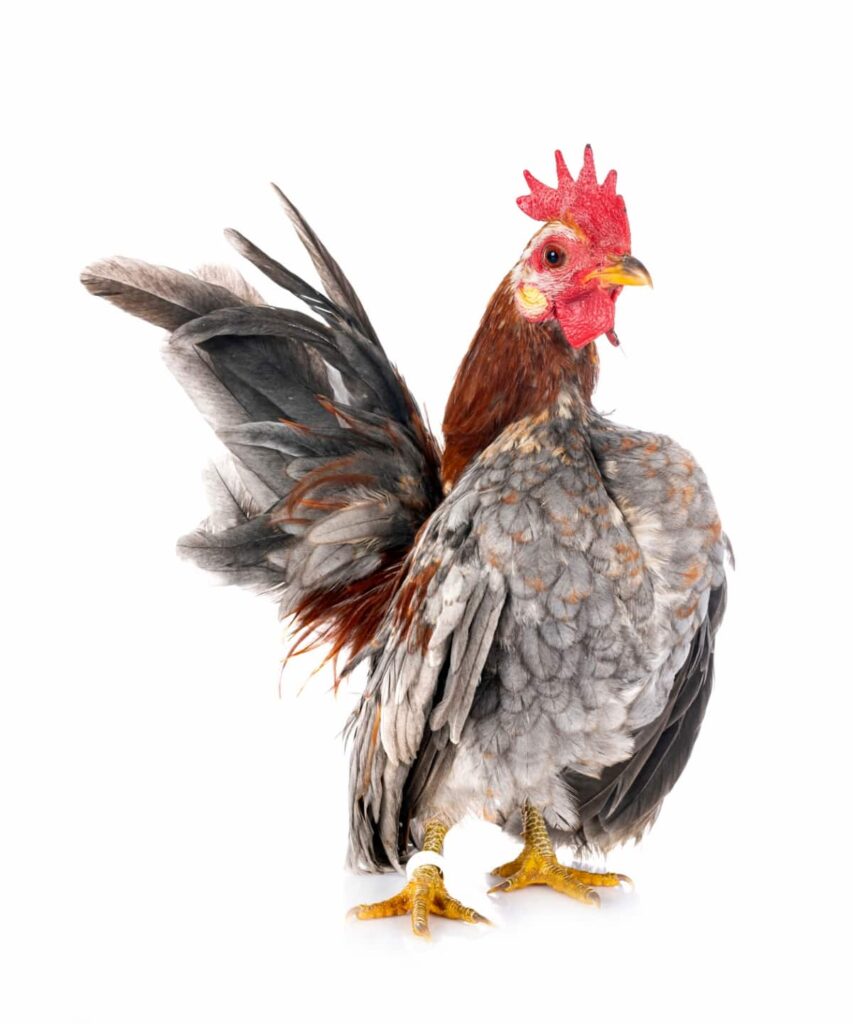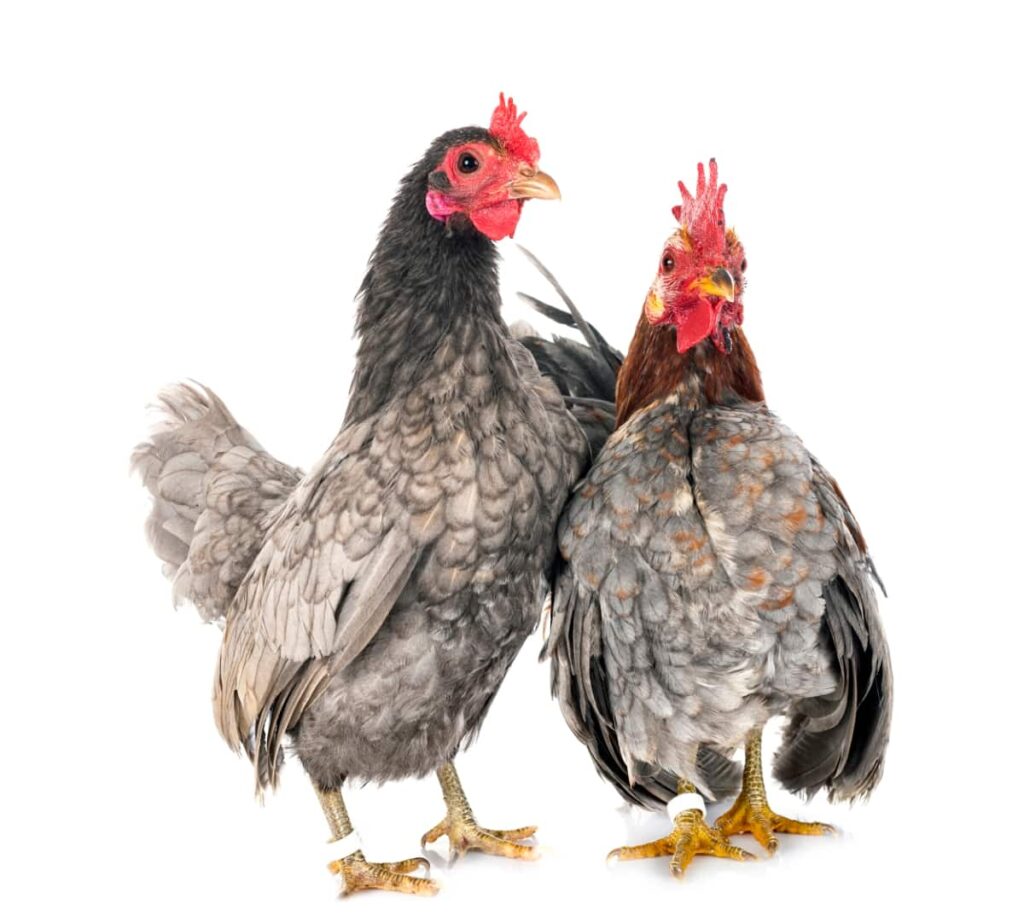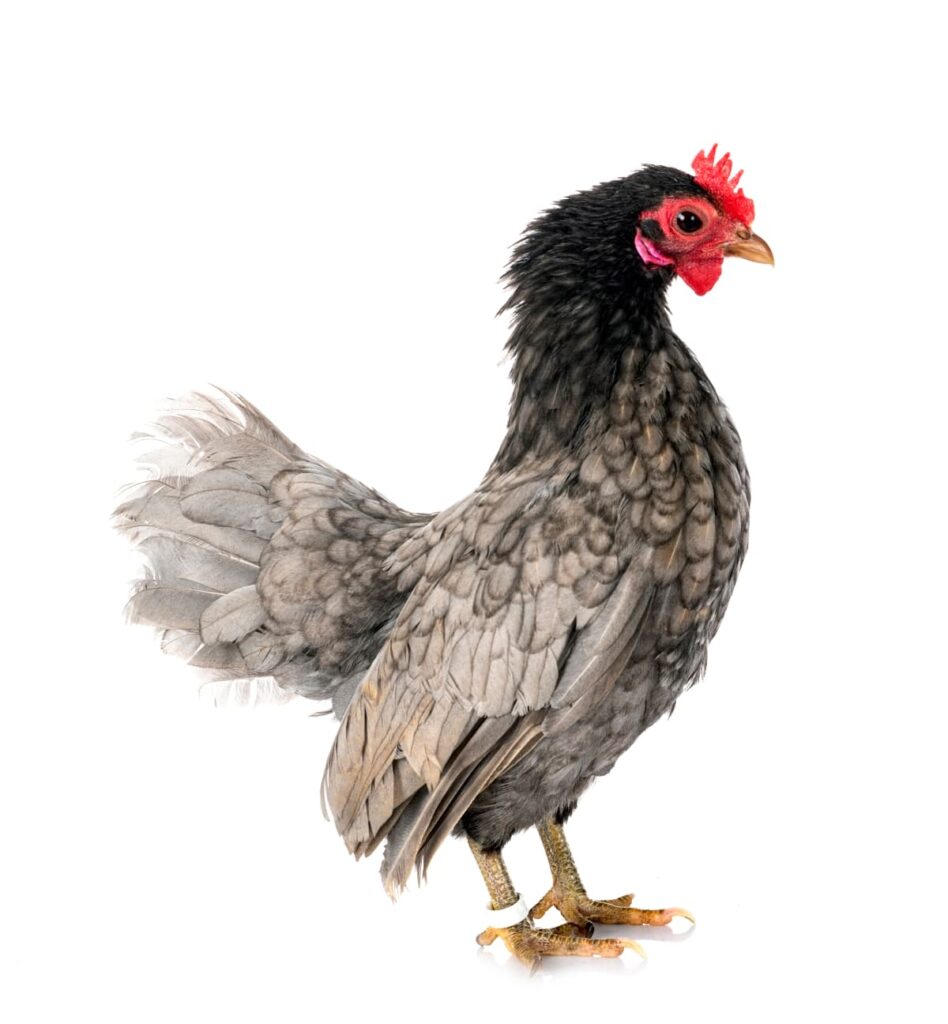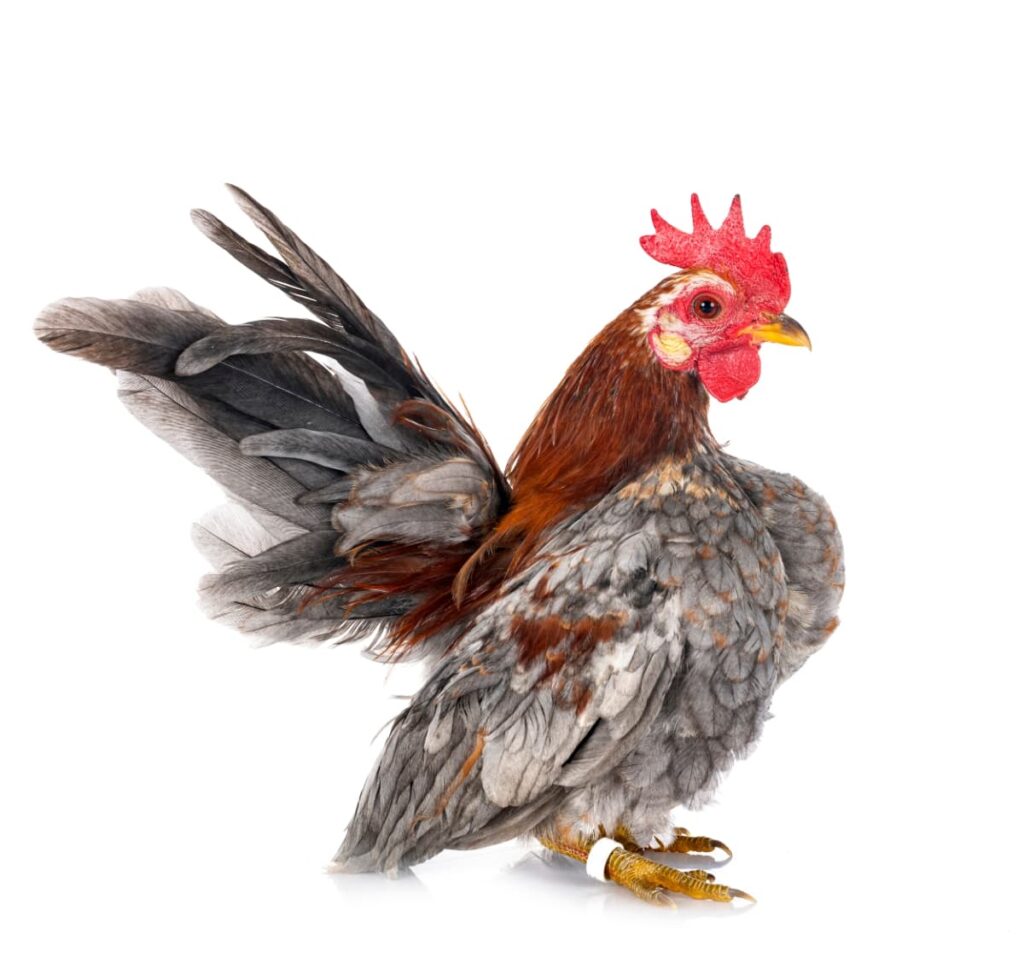Serama Bantams trace their roots back to the state of Kelantan in Malaysia, where they were developed in the early 2000s. The breed’s creation is attributed to the efforts of Malaysian breeders who aimed to produce a small, ornamental chicken with distinctive features. Through selective breeding, they achieved their goal, resulting in the Serama Bantam we know today.
Serama Chicken Characteristics
- Size: These bantams are the smallest breed of chicken in the world, with adults typically weighing between 225 grams to 540 grams.
- Appearance: They exhibit a compact body with a vertical posture, full breasts, and a short, upright tail. Seramas come in various color patterns and feather types, including smooth, frizzled, and silkied.
- Temperament: Despite their small size, Serama Bantams are known for their bold and confident personalities. They are often described as curious, friendly, and energetic birds that enjoy human interaction.
Serama Bantam Price
The price of Serama Bantams can vary depending on various factors such as lineage, quality, and location. Typically, high-quality Serama Bantam chicks or breeding pairs from reputable breeders can range from $20 to $100 or more per bird. Show-quality specimens with desirable traits may command higher prices.
Serama Bantam Lifespan
With proper care and attention, Serama Bantams can live relatively long lives compared to larger chicken breeds. On average, they have a lifespan of 5-10 years, although some individuals have been known to live even longer with excellent care. Providing a balanced diet, a safe and comfortable environment, regular veterinary check-ups, and plenty of social interaction can contribute to maximizing the lifespan of Serama Bantams.

Housing Serama Bantams
Coop Requirements: Serama Bantam Coop Designs
- Size: A coop with a minimum of 2 square feet per bird is recommended, but more space is always better, especially if they spend extended periods indoors.
- Protection: Ensure the coop protects from predators such as raccoons, foxes, and birds of prey.
- Ventilation: Incorporate vents or windows that can be opened and closed as needed.
- Nesting Boxes: Install nesting boxes where hens can lay their eggs comfortably. One box for every 4 hens is sufficient.
Outdoor Space
- Serama Bantams benefit from access to an outdoor run where they can forage, dust bathe, and explore.
- The run should be securely fenced to prevent escapes and protected from aerial predators with a secure cover or netting.
- Offer shelters within the outdoor space to provide shade during hot weather and protection from rain and adverse weather conditions.
Feeding and Nutrition
Basic Dietary Needs
- Provide high-quality commercial poultry feed formulated for bantam or small-sized chickens.
- The best diet for Serama Bantams should contain around 16-20% protein, suitable for supporting growth, feather quality, and overall health.
- Supply fresh, clean water at all times.
- Offer insoluble grit to aid in digestion, particularly if they do not have access to coarse materials like gravel or soil.
Supplements and Treats
- Fresh Greens: Supplement their diet with fresh greens such as lettuce, kale, spinach, or grass clippings.
- Protein Treats: Offer occasional protein-rich treats like mealworms, scrambled eggs, or cooked meat as a source of extra nutrition and to provide enrichment.
- Calcium: Provide sources of calcium, especially for laying hens, to support eggshell formation. Crushed oyster shells or commercial calcium supplements can be offered free choice.
- Fruits and Vegetables: Offer small amounts of fruits and vegetables as treats, but avoid feeding large quantities, which can upset their nutritional balance.
Health and Wellness
Common Serama Bantam Health Issues
Coccidiosis: A common parasitic disease affecting the intestinal tract, particularly in young chickens. Symptoms include diarrhea, lethargy, and decreased appetite. Prevention involves maintaining clean living conditions and providing medicated feed or water additives.
Respiratory Infections: Serama Bantams can be susceptible to respiratory infections in poorly ventilated or damp environments. Symptoms may include coughing, sneezing, nasal discharge, and difficulty breathing. Good ventilation, proper sanitation, and avoiding overcrowding can help prevent respiratory issues.
External Parasites: External parasites (mites and lice) can infest Serama Bantams, causing discomfort and irritation. Regular inspections and appropriate treatment with poultry-safe insecticides or dust baths can help control parasite populations.
Preventative Care: Serama Bantam Care
- Perform routine health checks on your Serama Bantams, including monitoring their behavior, appetite, and droppings.
- Follow recommended vaccination schedules to protect against common poultry diseases such as Marek’s disease and Newcastle disease.
- Maintain a clean and dry living environment, including regular removal of droppings, provision of clean bedding, and disinfection of feeders and waterers to minimize the risk of disease transmission.
- Ensure a balanced diet with access to fresh water and appropriate feed to support overall health and immune function.
In case you missed it: My Pet Chicken: How to Raise from Scratch

Breeding Serama Bantams
Breeding Basics: How to Breed Serama Bantams
- Pair Selection: Serama Bantam breeders should choose breeding pairs based on desirable traits such as size, conformation, color, and temperament. Avoid breeding birds with hereditary health issues or deformities.
- Breeding Enclosure: Provide separate breeding pens or enclosures for mating pairs to ensure privacy and minimize stress. Monitor breeding behavior and intervene if aggression occurs.
- Mating Process: Serama Bantams typically mate naturally, but artificial insemination may be necessary for birds with physical limitations or fertility issues.
Incubation and Hatching
Egg Collection: Collect Serama Bantam eggs for hatching promptly after laying and store them in a clean, cool environment with consistent temperature and humidity.
Incubation: Set up a reliable incubator with accurate temperature and humidity control. Follow the manufacturer’s instructions for optimal settings. Serama Bantam eggs typically require around 19-21 days of incubation.
Candling: Candle eggs periodically during incubation to monitor embryo development and identify any potential issues such as infertility or early mortality.
Hatching: Prepare a clean, warm brooder with bedding material ready for the hatching chicks. Once chicks begin to hatch, resist the urge to assist unless necessary, as interfering can cause harm.
Serama Bantam Temperament and Behaviour
Handling and Training
Gentle Handling: Serama Bantams, especially young chicks, are delicate and require gentle handling to avoid injury or stress. Support their bodies securely when picking them up and avoid sudden movements or loud noises.
Training Serama Bantams: While not as easily trainable as some other bird species, Serama Bantams can learn simple commands and behaviors through positive reinforcement techniques. As rewards, use treats for desired behaviors, such as coming when called or stepping onto a hand.
Serama Bantam Shows Standards and Competitions
Preparing for Shows
- Selection of Birds: Choose birds that meet the breed standard and exhibit desirable traits. Start with high-quality breeding stock and selectively breed for show-quality offspring.
- Conditioning: Ensure birds are in optimal condition by maintaining proper nutrition, grooming feathers, trimming nails, and treating health issues or parasites.
- Training and Handling: Familiarize birds with the show environment and handling procedures to minimize stress. Practice posing and presenting birds to showcase their best attributes.
Understanding Judging Criteria
- Breed Standard: Familiarize yourself with the standard set by the poultry association. Judges assess conformation, feather quality, coloration, and temperament.
- Conformation: Evaluate body shape, size, posture, and carriage.
- Feather Quality: Look for smoothness, glossiness, and uniformity of color and pattern.
- Coloration: Assess the accuracy, intensity, distribution, and patterning across the plumage.
- Temperament: While not part of the official criteria, judges may observe behavior.
In case you missed it: How to Raise Kikiriki Chickens: Origin, Behavior, Care, and Breed Information

Caring for Chicks
Brooder Setup
- Maintain a brooder temperature of around 35°C for the first week, then reduce by 2-3°C per week until reaching ambient temperature.
- Use clean, non-toxic bedding such as pine shavings or paper towels. Avoid materials that chicks may ingest.
- Provide enough space for Serama Bantam chicks to move freely without overcrowding, allowing at least 0.5 square feet per chick.
- Use a heat lamp or brooder plate to provide warmth. Ensure chicks can move away from the heat source to regulate their temperature.
Growth and Development
- Feed a high-quality chick starter feed containing around 20-24% protein. Offer small, frequent meals to promote growth.
- Provide access to clean and fresh water at all times. Monitor water temperature in cold weather to prevent chilling.
- Watch for signs of illness or distress, including lethargy, abnormal droppings, or respiratory issues. Seek veterinary care if necessary.
- Chicks will gradually develop feathers, starting with downy fluff. Monitor feather growth and provide appropriate heat until fully feathered.
In case you missed it: How to Raise Frizzle Chickens: A Comprehensive Guide for Beginners

Conclusion
In this comprehensive guide to Raising Serama Bantams, we’ve explored every aspect of caring for these captivating miniature chickens. From their origins and breed characteristics to housing, feeding, and health care, we’ve provided valuable insights for both novice and experienced poultry enthusiasts. This guide equips you with the knowledge needed to ensure their well-being and success in your care.
- Management Pests and Diseases in Your Cotton Field
- Sheep Farming Business Plan for Beginners
- Aquaponic Farming at Home: A Step-By-Step Guide
- Profitable Village Farming Business Ideas in 2024
- High-Yield Aquaculture: Fast-Growing Fish for Farming
- Effective Fish Pond Construction Techniques for Beginners
- Irrigation and Water Management in Pineapple Farming
- Blossom to Harvest: Mastering Flowering and Pollination in Papaya Farming
- Pig Fattening Essentials: From Selection to Sale for Beginners
